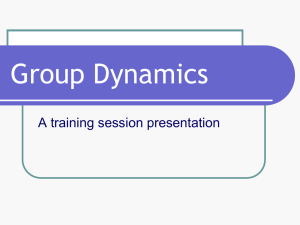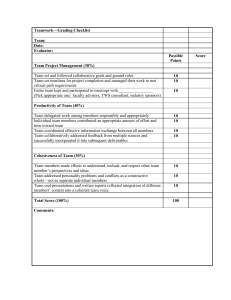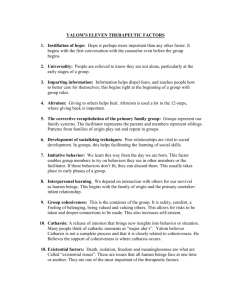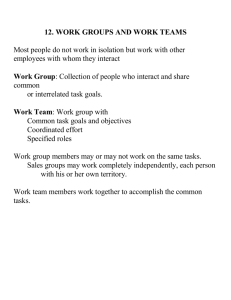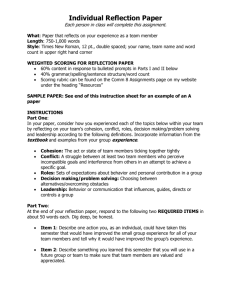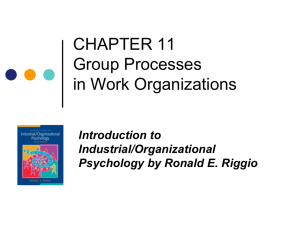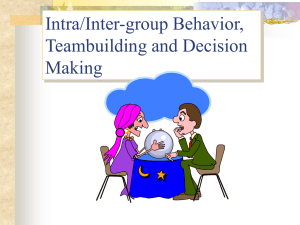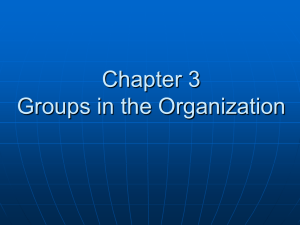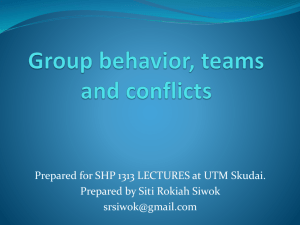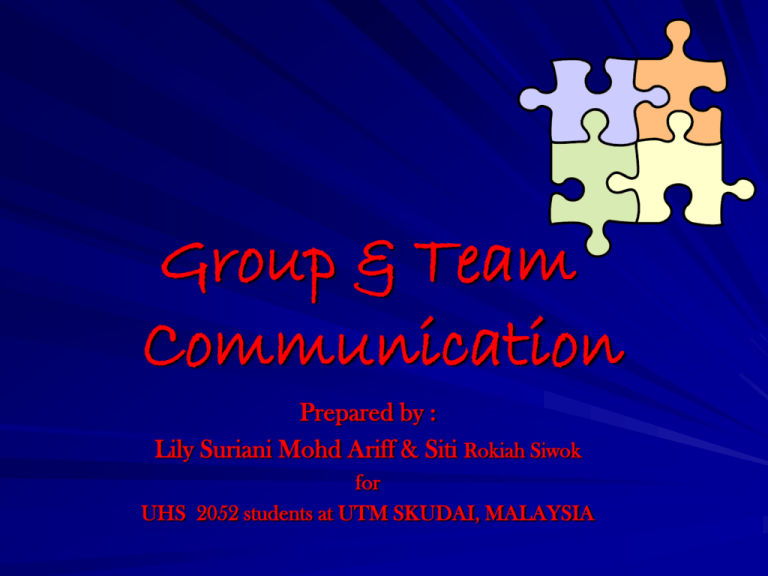
Group & Team
Communication
Prepared by :
Lily Suriani Mohd Ariff & Siti Rokiah Siwok
for
UHS 2052 students at UTM SKUDAI, MALAYSIA
Introduction
People seldom work in isolation ( Mullins, 2006).
Groups are characteristics of all social situations
( Mullins, 2006).
Most of a person’s behaviour takes place in
groups or teams; thus important to understand
group dynamics (Aamodt, 2007)
People in groups influence each other in various
ways.
Groups may develop hierarchies and leaders .
Styles of leadership affect groups.
Many other factors affect groups.
Introduction
Groups are crucial to the functions of work,
because through groups:
– Members can pool their resources (talents ,
energy etc)
– Provide professional identities for members
– Satisfies the human need for social interaction
– Develop of interpersonal relationships.
– Etc.
( Riggio, 2009)
Some Definitions of a group
Any no. of people interacting with one another,
psychologically aware of one another and
perceived themselves to be in a group ( Schein,
1988 in Mullins 2006).
A group is two or more individuals engaged in
social interaction to achieve some goal (Riggio,
2009)
A definable membership, group consciousness,
shared purpose, interdependence, interaction and
ability to act in a unitary manner ( Adair, 1986 in
Mullins 2006)
Some Definitions of a group
Four criteria must be met (Gordon, 2001 in
Aamodt, 2010):
– Members see themselves as a unit
– Group must provide rewards to members
– Members of the group share a common goal
– Corresponding effects(whatever happens to a
member affects every other member).
Some Definitions of a group
People who are related by:
– Perceptions
– Motivation
– Goals
– Organization
– Interdependence
– Interaction
6
A group is…….
A collection of individuals who influence
one another, have a common purpose,
take on roles, are interdependent and
interact with one another.
7
Why do we join groups?
8
Reasons why people join
groups
Psychological and social needs
Achieve goals
Information and knowledge
Security
Positive social identity
Proximity
Assignment
9
What are the factors affecting
groups?
Factors affecting Group
Performance
Group Cohesiveness
–
–
–
–
–
–
Group homogeneity
Stability of membership
Isolation
External pressure
Group size
Group status
Group ability and
confidence
Personality of group
members
Communication
network
Culture
Group roles
Presence of others
Individual dominance
Groupthink
Factors affecting Group
Performance: Cohesiveness
Group cohesiveness
– It is the extent to which group members like and trust
each other, committed to accomplish a team goal and
share a feeling of group pride ( Beale, Cohen, Burke
& McLendon, 2003 in Aamodt, 20010)
– Cohesiveness is the degree of attraction among
group members ( Riggio, 2009)
Cohesiveness
– Cohesiveness increases member satisfaction, but
only increases productivity when it is work-related.
– Cohesiveness increases when group members
have equal status.
– Cohesiveness increases with increased stability of
group membership.
– Greater similarity of group members increases
cohesiveness.
– The we-they feeling is cohesiveness created by
the existence of a threat to the group.
Group Cohesiveness
Group Cohesiveness are influenced by many
elements:
1. Group homogeneity
– It is the extent to which members are similar
– Homogeneous or heterogeneous will lead to the best
group performance?
2. Stability of membership
– The greater the stability, the greater the cohesiveness
– Thus members who remain for long periods of time
are more cohesive and perform better than groups
that have high turnover (Bell, 2005 in Aamodt, 2007)
Group Cohesiveness
3. Isolation
– Group that is isolated tends to be highly cohesive
4. External pressure
– Groups that are pressured by external forces tend to be
highly cohesive; which can be explained by the
phenomena psychological reactance ( Brehm, 1966 in
Aamodt, 2007)
5. Group size
– Groups are most cohesive and perform best when the size
is small.
– However, not all small group are always the best; also
depends on the tasks.
Group cohesiveness: Group Size
Smaller is best for cohesiveness
Performance depends on task
type
– additive tasks
– conjunctive tasks
– disjunctive tasks
16
Group Size and tasks
Additive tasks are the those for which the
group’s performance is equal to the sum of
the performances by each group member.
Each group member’s contribution is
important.
Larger group is better than small group
Group Size and tasks
Conjunctive tasks are those for which group’s
performance depends on the least effective
group’s member. Smaller groups are best.
Disjunctive tasks are those for which the
group’s performance is based on the most
talented group members. Larger groups are
better.
Examples of Task Types
Task Type
Group Activity
Additive
Typing pool
Relay race
Bowling team
Car washing
Disjunctive
Problem solving
Brain storming
Golf tournament
Conjunctive
Assembly line
Hiking
19
Group Size: variations
The additional of a new member to a group has
the greatest effect when the group is small.
Example: a single great player can turn a poor
basketball into a victorious team.
The effect of size is also different with different
apparatus used. Example:
With the use of computers, larger groups
appear to perform best and members are most
satisfied (
Dennis, Valacich and
Nunamaker, 1990 etc in Aamodt, 2010)
Group Cohesiveness
6. Group status
– The higher the group status, the greater is the
cohesiveness; thus a group can be made
more cohesive by increasing its status, at
least in the eyes of the members.
Cohesiveness and Productivity
i.
Cohesiveness - the ability of group members to get
along, the feeling of loyalty, pride, and commitment of
members towards the group. May be viewed as the
output of a group’s social dimension.
ii.
Productivity - the output from a group’s task
dimension. To the extent that a group accomplishes its
task, it is productive.
Cohesiveness and Productivity
iii.
iv.
Cohesiveness and productivity arecharacteristics that
describe to some degree the success of the group
process in every group.
In every group, both cohesiveness and productivity
exist in some amount. That is, a group’s productivity or
cohesiveness should each be visualized as some
point along the continuum. For example, in terms of
cohesiveness a group may be low, moderately low,
moderately high, high, and so forth.
Cohesiveness and Productivity
Common sense would dictate a direct relationship
between cohesiveness and productivity-that is the
more cohesive a group is, the more productive it is
likely to be. And this dictum is true-up to a point.
As a group raises its level of cohesiveness, the more
likely it is to raise its level of productivity. Conversely,
the more productive the group, the greater the
likelihood it will be more cohesive. However, the
relationship breaks down toward the upper end of the
two continuums.
Cohesiveness and Productivity
Extremely cohesive groups are more likely to
have moderate to low productivity. Although
the productivity of highly cohesive groups
probably doesn’t sink to the level of groups
that are extremely low in cohesiveness, such
groups are not nearly as likely to be as
productive as groups with moderately high
cohesiveness.
RELATIONSHIP BETWEEN
COHESIVENESS AND PRODUCTIVITY
1. The group may have been together so long
that its original purpose-its task-has suffered
simply because the members enjoy each
other’s company too much.
2. A group which is highly cohesive but has
low productivity has a great deal of “reserve
productivity.” That is, the group is capable of
much more productivity but simply does not
expend the effort to be productive. Hence,
its productivity lies dormant or in reserve.
Exhibit 15–5 The Relationship Between Cohesiveness and Productivity
© 2007 Prentice Hall, Inc. All
rights reserved.
15–27
Factors affecting Group
Performance
Group ability and confidence
– Groups with high-ability members outperform
groups with low-ability members
– Groups whose members believe that their team
can be successful perform better than those
whose members are not confident.
Personality of group members
– Groups with members who score high in
openness and emotional stability will perform
better that groups whose members do not have
these characteristics ( Bell, 2005 in Aamodt,
2007)
Factors affecting Group
Performance
Communication network
– Communication network affects groups’
performance
– The best network depends on the situation
and the goals of the group.
– A good leader must choose the best
communication network which facilitates the
achievement of the group’s goals.
Factors Affecting Group
Performance: Group Roles
Roles are patterns of behavior that are
adapted based on expectations about the
functions of a position in a group.
Role expectations are beliefs concerning
the responsibilities and requirements of a
particular role.
Role differentiation is the process by
which group members learn to perform
various roles.
(Riggio, 2009)
Factors Affecting Group
Performance: Group Roles
Early researchers (Benne and Sheats, 1948
cited in ) identified three categories of work
roles in groups.
– Group task roles are related to getting the
job done (e.g., leader, evaluator).
– Group building and maintenance roles deal
with maintaining personal relationships
among members (e.g., encourager,
compromiser).
– Self-centered roles involve satisfying
personal rather than group goals (e.g.,
recognition seeker, aggressor).
Group Task Roles
Initiator-contributor
Information seeker
Information giver
Opinion seeker
Opinion giver
Elaborator
Coordinator
Orienter
Evaluator/critic
Energizer
Recorder
Tester of agreements
Copyright © Allyn & Bacon 2008
32
Group Building and Maintenance
Roles
Encourager
Harmonizer
Compromiser
Gatekeeper
Standard setter
Follower
Feeling expresser
Copyright © Allyn & Bacon 2008
33
Self-Centered Roles
Aggressor
Blocker
Recognition seeker
Self-confessor
Buffoon
Dominator
Help seeker
Withdrawer
Copyright © Allyn & Bacon 2008
34
More elaboration on roles
Riggio, 2009, page 310
Riggio, 2009 page 310
Factors Affecting Group
Performance: Presence of Others
Social Facilitation and Inhibition
– mere presence of others
– comparison of performance
– evaluation apprehension
– distraction
Social Loafing
– effort won’t be noticed
– free-rider theory
– sucker-effect theory
38
Factors affecting Group Performance
:Individual Dominance
By the group leader
– If the leader has an accurate solution
to a problem in the group, then the
group performs at high level.
By a group member
39
Factors affecting Group
Performance: Groupthink
Groupthink is a syndrome characterized by a
concurrence-seeking tendency that overrides
the ability of a cohesive group to make critical
decisions.
Factors affecting Group
Performance: Groupthink
Can occur when the group :
is cohesive
is insulated from outsiders
believes it is infallible
it is morally superior
is under pressure to conform
has a leader who promotes a
favorite solution
has gatekeepers who keep
information from members
Aamodt, 2010
41
Riggio, 2009, page 334
Culture and its effect on groups
Individualistic assumptions
vs
Collective Assumptions
Individualist Assumptions
Individuals make better decisions
Leaders should do the planning
Individuals should be rewarded
Competition is good
Working individually is the best way to reach
goals
Groups are a waste of time
45
Collectivist Assumptions
Group’s decision supersedes individual decisions
Group should do the planning
Rewards should be shared by the group
Teamwork is more important than competition
Group is the best way to reach goals
Commitment to group is strong when group
reaches consensus
46
Types and Purpose of Small
Groups
What is a small
group?
1. A small group is a collection of individuals, few
enough in number so all member may communicate
with relative ease and function both senders and
receivers.
2. The ideal number is 5-7 people ( Sieler and Beal,
2011)
Generally, a small group consists of approximately 5-12
people. The important point to keep in mind is that each
member should be able to function both as sender and
receiver with relative ease. If the group gets larger than 12
members, this becomes difficult.
What are the characteristics of
small groups?
Interdependence
Commitment
Cohesiveness
Group size
Group Norms
Group culture
49
Types and Purposes of Small
Groups
There are two types of groups:
1. Primary Groups
2. Secondary Groups
50
Primary Groups: Social Focus
Socialization
Catharsis
51
Secondary Groups: Task Focus
Decision making
Problem solving
Committees
Leaning, Information
Sharing
Therapy, Personal
Growth
52
Groups or Teams?
53
Groups or teams?
There are some distinctions between group
involvement and team involvement.
A team is a special form of group,
characterized by close-knit relationships
among people with different and
complementary abilities, and by a strong
sense of identity( Sieler and Beall, 2011)
Teams
Similar to groups, teams also involve
interaction, interdependence, common
goals, personality, commitment,
cohesiveness and rules.
Teams
Teams differ from groups in three ways:
1. Teams are more likely to consists of people
with diverse abilities. Example: a surgical
team and a football team.
2. Usually develop more interdependence.
3. Have high degree of group identity and are
more likely to identify themselves as a team
members rather than as individuals who
happen to be on a team.
More descriptions of teams
What is a Team?
Donnellon (1996)
Identification
Interdependence
Power differentiation
Social distance
Conflict
management tactics
Negotiation process
58
Teams and Teamwork
(Riggio, 2009 )
A team is an interdependent group of
workers with complementary skills working
toward shared goals.
– Teams are most appropriate for complex
tasks, complex decision-making, or creative
tasks.
– Teams are also appropriate when the
situation is variable, requiring the team to
adapt to changing external conditions.
– Self-managing work teams have complete
responsibility for whole work tasks.
(Riggio, 2009, page 338)
All teams are groups, but not all
groups are teams
How Teams Develop
Tuckman (1965) Theory
Forming
– Team members get to know one another
– Everyone is on their good behavior
– Group clarifies its mission
Storming
– Disagreement and frustration set in
Norming
– Group members work at easing tension
– Acceptance of team leader
Performing
– Goals get accomplished
62
Types of Teams
Project Teams
Work Teams
Focus Group
Parallel Teams
Management
Teams
63
Project Teams
Exists in almost every type of organization.
Consists of variety of individuals who get
together to solve problems or make decisions.
In project teams, the individuals are usually
specially assigned to coordinate the successful
completion of an assigned task. Example: a
student affairs administrator or a campus police
detective.
Usually work under a dateline and work fast.
Work Teams
Exists in almost every type of organization.
Consists of variety of individuals who get
together to solve problems or make decisions.
Is a group of people who are responsible for the
entire work process or segment of the process
that delivers a product or service to an internal
or external customer.
Usually are subdivisions of a larger group; can
exist for an indefinite period of time or until a
specific project is completed.
Work teams
Work teams can also serve many
purposes, including solving problems,
making decisions, socializing and learning.
Groups and Teams
Although there are distinctions between
groups and teams, the differences are not
dramatic.
Exist on a continuum, some have more
characteristics of a group, while others
resemble more of a team.
(Sieler and Beall, 2011, page 414)
Work Team : Focus Group
Focus group is a special form of work team.
Usually consists of a manageable number of
participants plus a facilitator or leader
The goal for the formation of the team is to find
out what the members think about specific
ideas, issues or people.
Information obtained will be analysed and used
for decision making.
Exhibit 15–11 Characteristics of Effective Teams
© 2007 Prentice Hall, Inc. All
rights reserved.
15–69
Characteristics of Effective Teams
Are unified in their
commitment to team goals.
Have a clear
understanding of their
goals.
Have good communication
systems.
Have competent
members with relevant
technical and
interpersonal skills.
Possess effective
negotiating skills
Have appropriate
leadership
Exhibit high mutual trust
in the character and
integrity of their
members.
© 2007 Prentice Hall, Inc. All
rights reserved.
Have both internally and
externally supportive
environments
15–70
Other influences…..
Other Influences on Groups and
Teams
Technology
Creativity
Leadership
Gender
Conflict and Conflict Management
Technology: Virtual Groups
Newsgroups form via the Internet
Teleconferencing connects groups by
phone.
Videoconferencing connects groups via
television.
Interactive computer conferencing
connects groups via computers.
73
Creativity
Creativity
Creativity is a mental process involving the generation of
new ideas or concepts, or new associations of the
creative mind between existing ideas or concepts
Creativity is the ability to produce novel and useful ideas.
These ideas must be new and appropriate for the group
/organization.
Creativity is important to groups or organization for:
– Growth
– Improvement
– Development
Creativity
Ways to promote more creative thinking
– Brain storming /group discussion & activities
– Diversity
– Cross functional training
– Training
Creativity may be “stifled” by
– Time constraint
– Organization’s lack of openness
Creativity
There are several levels of creativity:
– emergent
– innovative
– inventive
– productive
– expressive.
Emergent Creativity
Involves bringing forth a principle or idea that is
entirely new to humankind, and that has farreaching effects on how we perceive reality.
Einstein and Newton come immediately to mind,
which explains why such a level may not be
attainable for most of us.
Innovative creativity
With innovative creativity, individuals build on
their knowledge of whatever field they are in,
climbing on the shoulders of their predecessors,
to reach even higher levels of new
understanding and ideas.
Inventive and Productive Creativity
Inventive creativity finds new uses for existing
concepts and parts
Productive creativity is the description given
when someone develops objects or ideas that
are new to him or her, but not necessarily to
other people. Quite often, this may be a
developmental stage for those who will, if they
do not get discouraged, move on to inventive or
innovative creativity.
Expressive Creativity
Expresses feelings and ideas but does not need
any particular skill or originality.
Example: Parents place drawings on
refrigerators or family notice-boards after young
children have excitedly brought their latest art
effort home from school.
Leader & Leadership
82
Leader & Leadership
An influence process that includes any behavior
that helps clarify a group’s purpose or guides the
group to achieve its goals.
A leader is a person who is assigned or
selected, or emerges from a group, to guide or
provide direction towards reaching the group’s
goal ( Sieler and Beall, 2011 page 431)
Copyright © Allyn & Bacon 2008
83
Who would you identify as a
great leader? Why?
What characteristics or behaviors
typify great leaders?
84
Leading a Group
Functions:
Initiate
Organize
Maintain effective interaction
Ensure member satisfaction
Facilitate understanding
Stimulate creativity and
critical thinking
85
Leadership Styles and
Behaviours
Research suggests that leaders can be
described as either:
(1) Task-oriented
(2) Relationship-oriented
Task-oriented leaders lead by initiating
structure
Relationship-oriented leaders lead by
consideration
86
Copyright © Allyn & Bacon 2008
87
Leadership Styles and Behaviour
Leadership can also be classified according to the
extent power is given to the group members.
Theoretically, there are three different styles:
1.
2.
3.
Autocratic: Keep control
Democratic: Share control
Laissez-Faire: Give up control
Leadership Styles:
A Comparison
Autocratic
Keeps control
Sets policy and
makes all
decisions
Defines and
assigns tasks
Democratic
Shares control
Involves group in
policies and
decisions
Allows members
to divide work
Laissez-Faire
Gives up control
Allows group to
make policies and
decisions
Avoids
participation
89
Leadership and Gender
Differences
90
Leadership and Gender
Differences
Research examines two dimensions:
1. Task accomplishment versus
maintenance of interpersonal
relationships
2. Participative (democratic) versus
directive (autocratic) leadership style
91
Challenges being in a group
Disadvantages of Small Groups
Groupthink
Time consuming
Varying communication style
Unfair workloads and social loafing
Pressure to fail
Grouphate Phenomenon
Disadvantages of Small Groups
Going along to get along: groupthink - too
much cohesion leads to conformity and
blind loyalty
Time consuming: problem solving takes
longer
Varying communication styles: not all
members can contribute equally
Unfair workloads: social loafing is
common
Copyright © Allyn & Bacon 2008
94
Disadvantages of Small Groups
Pressure to fail - May not reach potential
because of weak members
Grouphate phenomenon - Negative group
experiences or poor communication skills
inhibit some members
95
Ways to Reduce Groupthink
Assign a “devil’s advocate”
Prevent leaders from expressing their
opinions first
Give everyone the opportunity to speak
Encourage different viewpoints
Use technology for problem solving
Invite experts to review the conclusions
96
How is problem solving
conducted in groups?
97
Problem Solving and Decision
Making
Determining the problem
Discussing the problem
Applying reflective thinking
Brainstorming
Reaching group consensus
Copyright © Allyn & Bacon 2008
98
A Problem-Solving Model (Dewey)
Definition of problem
Analysis of problem
Suggestions of solutions
Selection of best solution
Putting best into operation
Copyright © Allyn & Bacon 2008
99
Brainstorming
1. Don’t criticize any idea
2. Encourage creativity
3. Seek quantity of ideas
4. Improve/add to suggestions of others
5. Record all ideas
6. Evaluate ideas
7. Allow enough time
8. Make brainstorming a group strategy
Copyright © Allyn & Bacon 2008
100
How do we deal with conflict in
groups?
101
Major styles in Responding to
Conflicts
1. Avoiding style
2. Forcing style
3. Accommodating
4. Collaborating style
5. Compromising style
(Wilmont and Hocker, 2007 in Aamodt 2010)
Ethical Behavior in Groups
103
Ethical Behavior in Groups
Group members:
State their opinions/perspectives
Share all legitimate information that benefits the
group
Show honesty and integrity
Keep confidential information confidential
Use information ethically
Copyright © Allyn & Bacon 2008
104
Most of us participate in smallgroup communication on a
regular basis. Becoming
effective group communicators
helps us in social and task
group settings.
105
References:
Seiler, W. J and Beall, M. L 2011). Communication. Making
Connections (8th ed). Boston: Pearson
Aamodt, M.G (2007). Industrial /organizational psychology. An
applied approach. Belmont, CA: Thomson.
Aamodt, M.G (2010). Industrial and organizational psychology. An
applied approach (6th ed) Belmont, CA: Wadsworth
Mullins, L.J. ( 2006). Essentials of Organisational Behaviour.
England: Prentice Hall
Riggio, R. E. ( 2009). Introduction to Industrial/Organizational
Psychology (5th ed). New Jersey: Pearson/Prentice Hall.
Corvette, B. A. B( 2006). Conflict Management. A Practical Guide to
Developing Negotiation Strategies.
New Jersey: Pearson
Some useful websites
http://www.practical-managementskills.com/conflict-in-the-workplace.html
http://sourcesofinsight.com/conflictmanagement-styles-at-a-glance/
http://www.workplaceissues.com/arconflict
.htm

